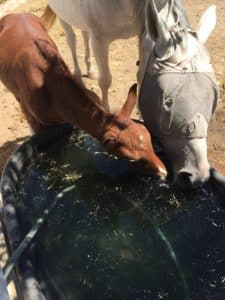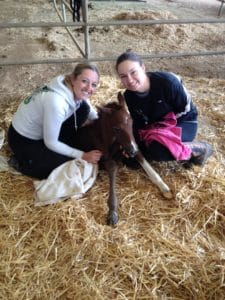
by LBEMC Admin
Share:
ARTICLE: A blind mare gives birth to her "Prime Time" foal.
Newborn foals sometimes require treatment. The joy and excitement of a new foal in the barn can quickly turn to stress and worry for all those involved. But, the challenges are even greater when the mare is blind. Felica, a sixteen-year-old Hanoverian mare is a valuable mare in her owner’s breeding program. After uveitis took her sight in one eye and glaucoma in the other, her owners decided it was still possible to breed their blind mare. Her foal arrived mid-afternoon right when he was due, earning him the name Prime Time.
“Once the mare had foaled we knew we had a challenge with the foal’s ability to stand on his own due to laxity in his hind limbs,” says Sandy his owner. The mare also wanted to stand right over the top of her new foal forcing the owners to stay with the pair around the clock to help the baby stand to nurse and protect him from the blind mare. Within a day, it was apparent he wasn’t properly passing his first stools, called meconium, and straining to urinate. They called out the ambulatory team from Loomis Basin Equine to begin treatment in the field.



By the next morning, when the colt had not passed any feces and had a distended abdomen he was referred to the clinic. “I thought they must be filled with dread having to take on a large, blind mare with her foal away from home in a hospital setting,” Sandy admits. But, the clinic is prepared for such situations.
The mare and foal were received into the neonatal intensive care facility. Prime Time had his own six-foot by five-foot box with a padded floor and sides three and a half feet high over which Felicia, the mare could nuzzle her foal. In his box, the foal could be extensively treated. Through their five day stay, he was catheterized, given intravenous fluids, nutrition, and plasma. Once the meconium impaction had passed, he was gradually reintroduced to nursing. Felicia had tolerated her situation well, even allowing the staff to continue to milk her. Despite being blind, the mare did very well throughout her stay remaining calm and content. Her colt also showed improvement in the laxity of his hind limb tendons.




